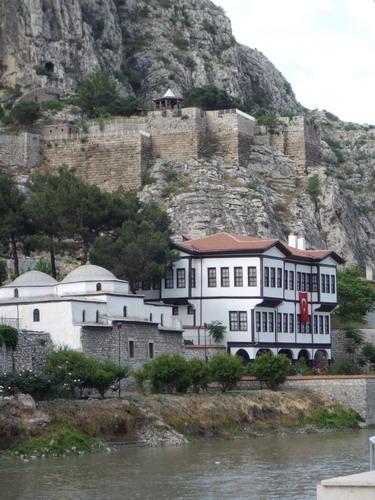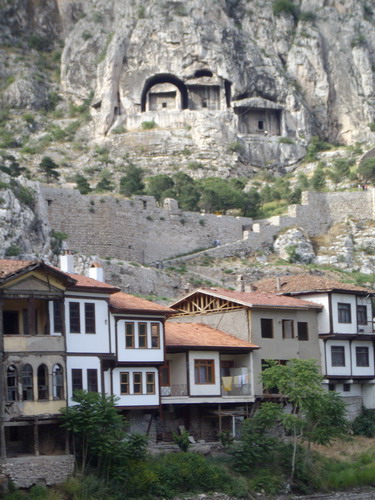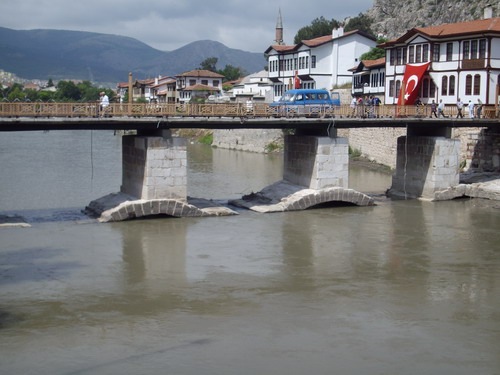I could have flown from Bodrum, near the place on the Turkish Aegean coast where I live part of the year, to the Black Sea coastal city of Samsun in the province of Amasya. But, for some reason the air ticket would have cost a fortune, whereas the coach (bus) cost all of 35 GBP (2.36 TRY – Turkey Lira).
 Honestly, I was stiff as a plank, which was hardly surprising considering that I had just sat for 16 solid hours on a Turkish long distance coach. Those huge overland buses are pretty comfortable and they do stop every three hours for a half hour break. But even so, it was a bit of an ordeal. When I finally got off, dawn was just breaking and the sight that hit my eyes made me forget any aches and pains in the blink of an eye.
Honestly, I was stiff as a plank, which was hardly surprising considering that I had just sat for 16 solid hours on a Turkish long distance coach. Those huge overland buses are pretty comfortable and they do stop every three hours for a half hour break. But even so, it was a bit of an ordeal. When I finally got off, dawn was just breaking and the sight that hit my eyes made me forget any aches and pains in the blink of an eye.
Before my eyes were Amasya’s famous wooden houses, practically glued to the side of a sheer mountain cliff with the tombs of the Kings of Pontus looming over them and, even higher up in seven levels of solid walls, a gigantic castle, all backlit by the rising sun.
Down below, the gushing Yesil River rushed through the gorge, moving water mills and flowing under ancient bridges. It’s difficult to decide which is the first of the many amazing sights this town of no more than 87,000 inhabitants has to offer visitors.
Amasya’s history goes back to 5,500 BC when the Hittites settled there. Seven more cultures followed – the Phrygians, the Lydians, the Persians, the Greeks, then the Roman and Byzantine civilizations which lasted 700 years. These peoples were all suceeded by the Seljuks and Ottomans until, in 1919, Atatürk, the founder of the Turkish Republic, declared the Turkish War of Independence in the Amasya Circular.
 Each and every culture left its mark, with monuments and oral histories that can still be admired today, either directly or in two of Amasya’s museums. Apart from man made sites, there are also the impressive natural wonders to take in, including: the steep mountain cliffs, the meandering river and the many fertile fields surrounding Amasya which is famous for its apples, vegetables and poppy plants.
Each and every culture left its mark, with monuments and oral histories that can still be admired today, either directly or in two of Amasya’s museums. Apart from man made sites, there are also the impressive natural wonders to take in, including: the steep mountain cliffs, the meandering river and the many fertile fields surrounding Amasya which is famous for its apples, vegetables and poppy plants.
Tired or not, I checked into my hotel which was located in a converted wooden house, and then started my climb up to the castle. At half point, you reach the mountain tombs of the Kings of Pontus. Here, you can get very close for a look inside from the carved openings that front the river. Admittedly, I didn’t make it all the way up to the top of the castle which was as an important defense fortress during the time of Alexander the Great and has served the same purpose through all of the subsequent cultures and reigns.
I finished my excursions for the day by climbing back down and walking along the Yesil River on a very pleasant promenade which stretches for a good two  miles. The promenade, shadowed by trees and arches covered in rose bushes, leads to an out-door museum featuring many bronze statues which reflect Amasya’s colorful history.
miles. The promenade, shadowed by trees and arches covered in rose bushes, leads to an out-door museum featuring many bronze statues which reflect Amasya’s colorful history.
In an effort to recharge my my batteries, I found a delightful garden café where I sampled one of Amasya’s specialities: apple pie and a gözleme (paper thin puff pastry) filled with poppy seeds. As you can imagine, I slept like the dead that night. I was awakened the next morning by the call to prayer from a nearby mosque and immediately got ready for another day of exploring Amasya’s amazing historical attractions.


Comments